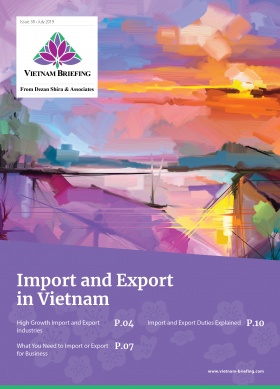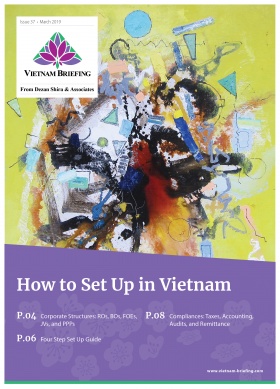An Introduction to Rules of Origin for Vietnamese Exports
- Investors looking to take advantage of lower tariffs must understand and comply with rule of origin guidelines.
- Vietnam is a party to several free trade agreements making it an ideal destination for manufacturers looking to produce goods there.
- As Vietnam benefits from the myriad of agreements, it has also increased scrutiny on products that defy rule of origin guidelines.
For businesses seeking to take advantage of tariff-free exports and low labor costs, Vietnam has become the ideal destination.
In 2019, manufacturing and processing accounted for 64.6 percent of total investment capital and with the recent signing of several free trade agreements, including the European Union-Vietnam FTA (EVFTA) and the Comprehensive and Progressive Agreement for Trans-Pacific Partnership (CPTPP), this amount is expected to rise.
As a compliment to pending agreements, Vietnam already benefits from operational FTAs with members of the Association of Southeast Asian Nations (ASEAN), China, Japan, South Korea, India, New Zealand, Australia, and Russia.
Although FTA agreements present a tempting way to lower export costs, the ability to tap into their benefits is largely contingent upon compliance with elaborate rules outlined within each agreement. At hundreds of pages in length, agreements set out specific tariff concessions and compliance requirements at a product-specific level.
Rules of origin: A primer
In order to ascertain the manner in which goods will be treated, it is first necessary to identify the Harmonized System (HS) code that will be designated to the finished product. This is to determine the applicable tariff. The HS system is a classification of products and allows participating countries to classify traded goods for customs purposes. HS codes classify goods in a six-digit code system.
From a compliance perspective, HS codes are also used to determine the requirements that a good will be subject to under an FTA. Areas of compliance will often pertain to the manner in which a good is produced, how it is labeled and the certifications that it requires to be exported and recognized.
To understand the specifics applied under a given agreement, one of the most important sections of an FTA is that of rules of origin. Rules of origin establish the method by which signatories of free trade agreements determine if goods entering their borders qualify for the benefits of the agreement.
It is also important to note that rules of origin are included and utilized within international law to determine when to apply anti-dumping duties.
In order for Vietnamese exports to qualify for tariff reductions under free trade agreements of which Vietnam is a participant, rules of origin requirements mandate varying degrees of the manufacturing process to be conducted within Vietnam.
The objective of these rules is to enforce the trade agreement and to prevent third parties from free-riding off of the concessions of FTA signatories. Adapting to the complex and global nature of many corporate supply chains, rules of origin chapters have become increasingly complex and require careful due diligence to ensure compliance.
Product-specific requirements
For a product to benefit from tariff reduction, it must “originate” from a country party to the trade agreement. The product can be “wholly obtained” from that nation or meet certain requirements in the event that the product is “not wholly obtained”.
“Wholly obtained goods”
These generally refer to raw materials and other resources such as livestock and agriculture. These goods must be sourced exclusively from within the FTA zone or territory to qualify for tariff reductions. Under many free trade agreements, a list of goods that must meet these requirements is specified.
For companies involved in the sale of similar goods from multiple jurisdictions, it will be important to ensure a thorough understanding of how raw materials and other exports are treated under Vietnam’s FTA framework. For companies exporting goods from both Vietnam and China, it may not be possible for Chinese produced goods to qualify for tariff reductions under certain agreements.
Goods not “wholly obtained”
While some goods must be entirely sourced in Vietnam by their inclusion under FTAs as wholly obtained goods, modern trade agreements also attempt to accommodate the rise of multinational supply chains through certain allowances. Outlined under trade agreements as regulations pertaining to not wholly obtained products, many goods must meet certain requirements to benefit from tariff reductions.
There are two ways that a not wholly obtained product is generally classified as eligible for tax breaks:
- It has been sufficiently transformed within the FTA zone; and
- A certain percentage of the product is originating from that area.
The standard for each of these categories varies based on the agreement and the goods in question. It is common for FTAs to require that a certain percentage of inputs be sourced from within the FTA zone and that the goods undergo a degree of change within the zone to qualify for reductions. Furthermore, the technique by which the value for each category is evaluated differs based on the agreement and the goods in question.
For companies attempting to benefit from tariff reductions, the challenge is not only to navigate complex rules that determine an originating product, but also to manufacture goods in a way that is suitable under several trade agreements. It is crucial to conduct a cost-benefit analysis of manufacturing in accordance with the complex FTA guidelines.
Supply chain and logistics optimization
Vietnamese based operations are never far away from potential suppliers in China and India, while a great distance from sources of demand in the Americas and Europe. To facilitate regional supply chain integration and support the shipment of goods to their final destination, free trade agreements increasingly implement articles dealing with extra FTA supply and transit.
Advantages of cumulation
In an attempt to further adjust to extensive supply chains, articles pertaining to cumulation allow companies to maintain multinational supply chains without losing originating status. Because it is impractical for businesses to manufacture entirely in one nation, FTAs authorize the producer to tap into tax reductions while utilizing the comparative advantage of several countries that may not be included within the FTA in question.
Manufacturers can work in countries within the zone of an FTA or in a nation collaborating with the agreement. For example, under the EU-Vietnam FTA, if a fabric originating in South Korea is brought to Vietnam and further processed, it can be considered as originating in Vietnam and applicable to the tariff break under the agreement.
Those with existing supply chains in close proximity to Vietnam should review articles of cumulation found within Vietnam’s FTA network to ensure that goods are afforded the lowest tariffs possible upon export.
Transit/Transshipment
To accommodate companies whose products are shipped through several ports, FTAs ensure that applicable goods do not lose preferential status simply due to the transit route. While this gives manufacturers the freedom to ship along the best-suited lane, importers may require proof that the good was in no way altered at an intermediate location, which would disqualify it from the reduced tariff.
Challenges
The rules of origin under the FTAs are incredibly detailed and complex. Nations may also be part of several FTAs that have different rules of origin. With extensive supply chains, it is important for companies to harmonize them in accordance with the varying trade agreements. Manufacturers are also obligated to keep records of the eligibility of their goods and are subject to customs audits. At the very least, this involves keeping track of the origin of the materials.
Note: This article was first published in June 2016 and has been updated to include the latest developments.
About Us
Vietnam Briefing is produced by Dezan Shira & Associates. The firm assists foreign investors throughout Asia from offices across the world, including in Hanoi and Ho Chi Minh City. Readers may write to vietnam@dezshira.com for more support on doing business in Vietnam.
- Previous Article COVID-19 in Vietnam: Reisebestimmungen
- Next Article COVID-19 and the Effects on Supply Chains in Vietnam







